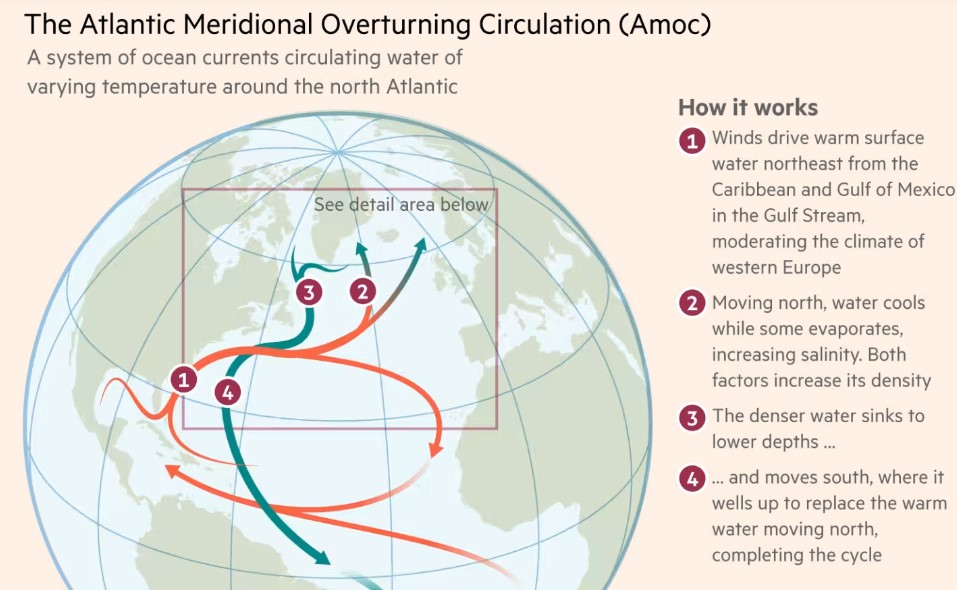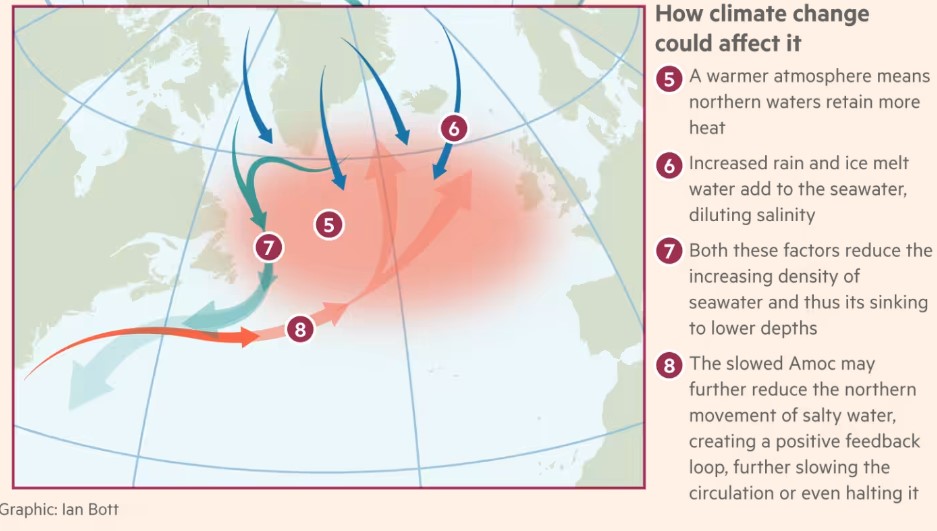By John Pickard
A peer-reviewed scientific paper in Nature this week has suggested that the Gulf Stream could collapse much earlier than anticipated. This would have dramatic, if unpredictable, effects on the weather in the UK and the rest of Europe.
When most of us were at school, the huge current that brought warm water to the North Atlantic from the Gulf of Mexico was simply called the ‘Gulf Stream’. It works by funneling warm water to the North Atlantic, where it cools, and its greater salinity (and therefore density) causes it to sink. This great body of water then moves back South, sub-surface, to rise and warm up again in the tropics. [See graphics from Financial Times below]
This vast, oceanic convection current transports a huge amount of heat to Northern latitudes. It has been the mainstay of our weather system for tens of thousands of years. The huge amount of heat it drags Northwards is equivalent to millions of power stations-worth of energy. For the British Isles, for example, even though we are just as near to the North Pole as continental Europe, it has meant that our maritime climate is comparatively benign – warmer and damper in Summer, but wetter and milder in Winter.

Gulf Stream already at its weakest for 1,600 years
But the Gulf Stream, scientifically named the Atlantic Meridional Overturning Circulation (Amoc), may collapse much earlier than originally anticipated, even in the next few years, with disastrous consequences. It has been known from scientific date for some time that it is at its weakest for 1,600 years, but the continued warming of the oceans and the melting of glacial Greenland ice, may push it past a tipping point.
Previous estimates – and the one still held by the United National Panel on Climate Change, the IPCC – are still for a collapse towards the end of the century, but new data challenges that view. A recent study concludes, with a 95 per cent degree of confidence, that the Amoc will collapse at some point between 2025 and 2095, with the 2050s most likely, and possibly as early as 2025. Its authors consider the IPCC view to be “too conservative” in the light of new data and warning signs.

The article in Nature is available here as a PDF, and it has caused considerable consternation among climatologists. One scientist, David Thornalley, of UCL, suggested that further study was essential, but added that “if the statistics are robust and a relevant way to describe how the actual Amoc behaves, then this is a very concerning result.”
“There is still large uncertainty where the Amoc tipping point is”, suggested Professor Stefan Rahmstorf, at the University of Potsdam, “but the new study adds to the evidence that it is much closer than we thought”.
A collapse at the end of the century is bad enough
Professor Peter Ditlevsen, from the University of Copenhagen in Denmark, the scientist who led the new study, told the Guardian (July 25), “I think we should be very worried. This would be a very, very large change. The Amoc has not been shut off for 12,000 years.” It should be noted that not all scientists agree with the new study and are staying with the IPCC forecast of a collapse at the end of this century – which is bad enough. But the latest data is certainly not good news.
Another expert, Tim Lenton, professor of climate science at Exeter university, and a world expert on tipping points, told the Financial Times (July 25), “The evidence is mounting and is in my view alarming.”. He added that the report “made important improvements to the methods of providing early warning of a climate tipping point directly from data” and “once past the tipping point, the collapse of the Amoc would be irreversible”.
It is understandable that the possibility of a collapse much earlier than anticipated has alarmed climate scientists. Although the most immediate effects would be in the North Atlantic, its ramifications would spread far wider, disrupting weather and rain patterns as far away as South Asia and continental North America.
Greenland ice sheet melting far quicker than expeted
Last year, scientists suggested that the amount of global warming we already have – at least 1.1oC – has led to five important ‘tipping points’ being passed. These include the collapse of the Greenland ice sheet, releasing billions of tons of water a year into the North Atlantic, the melting of Northern European and Siberian permafrost, and the collapse of the Gulf Stream. It is the latter which has been confirmed by this new data analysis.

While the new paper in Nature magazine caught the attention of most of the serious media (we wouldn’t expect propaganda rags like the Mail, Express and Sun to even notice it), no attention was given to a second paper, also published in the same magazine.
Astonishing for politicians to row back on climate pledges
Entitled, Future increased risk from extratropical windstorms in northern Europe, this paper dealt with possible weather effects caused by the increased average temperature of the North Atlantic and specifically to wind damage and subsequent “socioeconomic losses”.
Here, the paper’s authors say in their summary, “we show storm frequency increases across northern and central Europe, where the meteorological storm severity index more than doubles”. As you would expect in a serious scientific paper, much of the content is very technical and rather opaque to non-scientists, but the general message is clear: with climate change, look out for serious ‘anomalous’ weather, particularly storm-force winds, in the coming years and be prepared for the economic damage they cause.
The paper shows “that parts of Europe will experience increases in the intensity of the extreme winds”, and it goes on to discuss the damage, depending how buildings are adapted to the much more frequent adverse weather events. It is not a political paper, of course, and there is no discussion about the likelihood – or the unlikelihood – of governments planning to adapt to climate change.
Given the welter of bad news that comes out regularly about climate damage, it is astonishing that the Tory government are being urged by backbenchers and the Tory press to ‘tone down’ its already weak commitments to zero carbon.
It is a disgrace that Keir Starmer, too, is abandoning, step by step, what little green policy commitments he has agreed. Successive Labour Party conference resolutions show that there is widespread support in the labour movement for ‘green’ socialist policies – a Green New Deal.
Socialists in the labour movement, like all rational people, are right to be dismayed by the catalogue of bad news on the climate. But such news should spur us on to redouble our efforts to fight for a future for our children and grandchildren – and that means a fight for socialism. Socialist policies have to be green socialist policies.




Since the publication of this article, we have been corrected. Like most media science correspondents, we have conflated the Amoc with the Gulf Stream and here is a link to a scientific correction from Dr Jonathan Foley. It is true that global warming will produce dramatic and unprectable changes to weather patterns in the UK and Europe, but we should nontheless do our best to get the Science right.
https://twitter.com/GlobalEcoGuy/status/1683956619892121600?t=Q9R9QlNDaJ5GH2iD3PmlcQ&s=19&fbclid=IwAR1MsOobi6PwQogZVANuPlyx4Jp1R_WpRlMrdqbfzTPfUR_Slhggu3blkPM